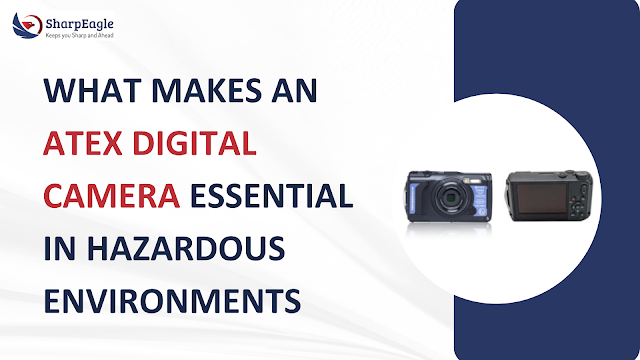How to Choose the Right ATEX Camera for Your Industry
In hazardous industrial environments where explosive gases, vapors, or dust are present, safety is not just a requirement, it’s a regulatory mandate. Capturing images or video in such conditions demands more than just a regular digital camera. That’s where ATEX-certified digital cameras come into play. These specialized devices are built to withstand and operate safely in explosive atmospheres, helping industries monitor, inspect, and document processes without compromising safety.
But with multiple options available in the market, how do you choose the right ATEX digital camera for your specific industry? In this blog, we’ll walk you through the key factors, certifications, and use-case considerations that will help you make an informed decision.
What Is an ATEX Digital Camera?
ATEX stands for Atmosphères Explosibles, a European directive that governs equipment used in potentially explosive atmospheres. An ATEX digital camera is a rugged imaging device designed and certified to be safely used in hazardous zones where there is a risk of explosion due to the presence of flammable gases or dust.
These cameras are typically used in oil and gas fields, petrochemical plants, chemical processing units, mining operations, and manufacturing facilities where safety compliance is critical.
Why You Need an ATEX Certified Camera
Using non-certified devices in ATEX zones can lead to catastrophic accidents. Regular digital cameras can emit sparks, overheat, or have exposed electronics that could ignite volatile substances. In contrast, ATEX digital cameras are:
- Explosion proof and intrinsically safe
- Sealed and temperature controlled
- Certified for specific ATEX zones (Zone 0, 1, or 2)
They allow personnel to capture images for inspection, reporting, maintenance, and evidence, without endangering the worksite.
Factors to Consider When Choosing an ATEX Digital Camera
1. Zone Classification
ATEX zones are categorized based on the likelihood of explosive atmospheres:
- Zone 1: Likely presence under normal operations
- Zone 2: Rare presence of explosive gases
Make sure the camera is certified for the specific zone your operations fall under. Cameras designed for Zone 2 may not be suitable for Zone 0, where risk levels are significantly higher.
2. Camera Build Quality and Housing
Choose a camera with rugged housing, typically made from aluminum or stainless steel, to withstand harsh conditions such as vibrations, moisture, corrosion, and dust. Look for IP66 or IP67 ratings for ingress protection against water and dust, which is essential in outdoor or offshore environments.
3. Battery and Power Management
An ideal ATEX camera will have long battery life and intrinsically safe power systems that prevent overheating. Some cameras also feature hot-swappable batteries, allowing for longer usage without re-entering hazardous zones for charging.
4. Image and Video Quality
Even in hazardous zones, image clarity is crucial. Look for cameras with:
- High-resolution sensors (8 MP or higher)
- Video capability (1080p Full HD or 4K)
- Zoom and macro features for detailed inspections
- Low-light performance for dimly lit environments
This ensures the images captured can be used for technical analysis, documentation, or evidence in safety audits.
5. Connectivity and Data Transfer
Modern ATEX cameras often come with Wi-Fi, Bluetooth, or USB connectivity options, enabling fast and secure transfer of images and videos. Some models allow remote access or real-time monitoring — ideal for offshore rigs or areas where physical access is limited.
6. Certification and Compliance
Verify that the camera is certified not just under ATEX but also other applicable standards like:
- IECEx — International Electrotechnical Commission Explosive Atmosphere Certification
- UL / CSA — North American explosion proof standards
- RoHS — Restriction of Hazardous Substances compliance
Brands like SharpEagle offer Explosion proof digital cameras that meet global safety standards, making them reliable across multiple regulatory environments.
7. Ease of Use & Ergonomics
Field technicians often work in PPE, gloves, and harsh environments. Your camera should be:
- Lightweight and portable
- Operable with gloves
- Equipped with a clear screen, physical buttons, or touch interface
Additionally, features like one-touch capture, voice notes, or laser pointers can be useful for inspections and reporting.
Industry-Specific Considerations
Oil & Gas
- Look for cameras with Zone 0 or 1 certification
- High corrosion resistance (for offshore and chemical exposure)
- Long battery life for extended field inspections
Chemical & Petrochemical
- ATEX Zone 1 certification minimum
- Easy decontamination and chemical resistance
- Real-time data transfer for monitoring
Mining
- Dust-tight, shock-resistant design
- LED flash or IR for underground visibility
- Certifications for combustible dust zones (Zone 21/22)
SharpEagle - A Trusted Name in ATEX Camera Solutions
SharpEagle Technology offers a range of ATEX and IECEx certified digital cameras designed specifically for high-risk industries. Their cameras feature:
- Durable, explosion proof design
- Full HD imaging and video capability
- Long battery life and easy usability in the field
- Compliance with Zone 1 & Zone 2 standards
With a strong reputation across the Middle East, Asia, and Africa, SharpEagle continues to be a trusted partner in workplace safety and hazardous zone monitoring.
Final Thoughts
Choosing the right ATEX digital camera requires a clear understanding of your work environment, safety regulations, and technical needs. It’s more than just buying a rugged camera - it’s about ensuring safety, compliance, and operational efficiency in hazardous zones.
Whether you’re in oil & gas, mining, or chemical processing, an ATEX-certified camera from a trusted brand like SharpEagle Technology is an investment in safety and reliability.




Comments
Post a Comment